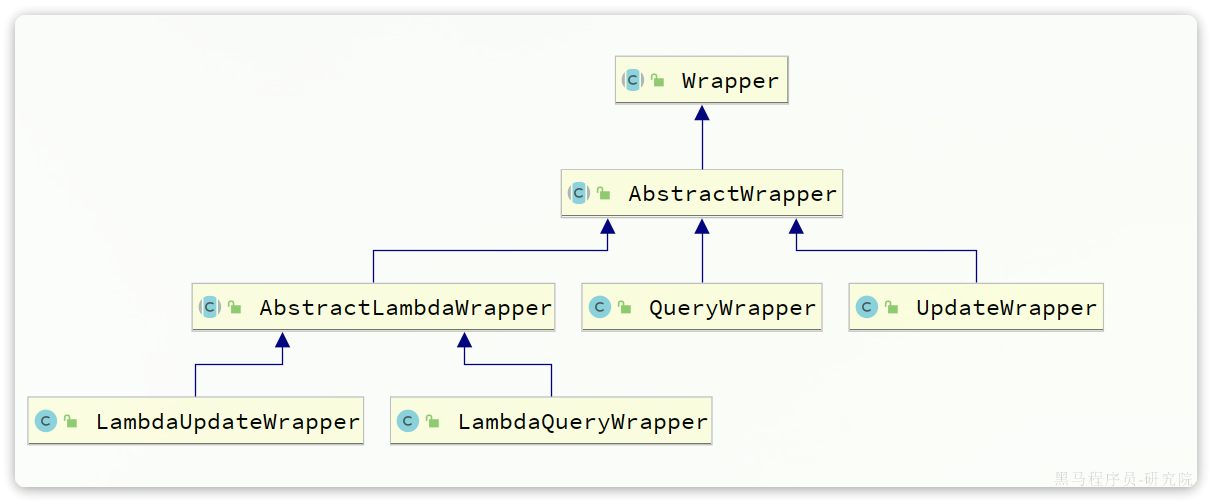简介
MyBatis-Plus 是一个 MyBatis 的增强工具,在 MyBatis 的基础上只做增强不做改变,为简化开发、提高效率而生。引入它不会对现有工程产生影响,如丝般顺滑。
依赖
1
2
3
4
5
| <dependency>
<groupId>com.baomidou</groupId>
<artifactId>mybatis-plus-boot-starter</artifactId>
<version>3.5.3.1</version>
</dependency>
|
注解
@TableName(value = "", schema = ""....)
- 描述:表名注解,标识实体类对应的表
- 使用位置:实体类
除了常见的value属性,还支持如下属性
| 属性 |
类型 |
必须指定 |
默认值 |
描述 |
| value |
String |
否 |
“” |
表名 |
| schema |
String |
否 |
“” |
schema |
| keepGlobalPrefix |
boolean |
否 |
false |
是否保持使用全局的 tablePrefix 的值(当全局 tablePrefix 生效时) |
| resultMap |
String |
否 |
“” |
xml 中 resultMap 的 id(用于满足特定类型的实体类对象绑定) |
| autoResultMap |
boolean |
否 |
false |
是否自动构建 resultMap 并使用(如果设置 resultMap 则不会进行 resultMap 的自动构建与注入) |
| excludeProperty |
String[] |
否 |
{} |
需要排除的属性名 @since 3.3.1 |
@TableId(value = "id", type = IdType.AUTO)
- 描述:主键注解,标识实体类中的主键字段
- 使用位置:实体类的主键字段
IdType 是枚举类,默认值为ASSIGN_ID,支持的类型如下
| 值 |
描述 |
| AUTO |
数据库 ID 自增 |
| NONE |
无状态,该类型为未设置主键类型(注解里等于跟随全局,全局里约等于 INPUT) |
| INPUT |
insert 前自行 set 主键值 |
| ASSIGN_ID |
分配 ID(主键类型为 Number(Long 和 Integer)或 String)(since 3.3.0),使用接口IdentifierGenerator的方法nextId(默认实现类为DefaultIdentifierGenerator雪花算法) |
| ASSIGN_UUID |
分配 UUID,主键类型为 String(since 3.3.0),使用接口IdentifierGenerator的方法nextUUID(默认 default 方法) |
| ID_WORKER |
分布式全局唯一 ID 长整型类型(please use ASSIGN_ID) |
| UUID |
32 位 UUID 字符串(please use ASSIGN_UUID) |
| ID_WORKER_STR |
分布式全局唯一 ID 字符串类型(please use ASSIGN_ID) |
@TableField
只有特殊情况下我们才需要给字段添加@TableField注解:
配置
和 MyBatis 的配置几乎一样,
1
2
3
4
5
| mybatis-plus:
type-aliases-package: com.hmall.service.domain.po
global-config:
db-config:
id-type: auto
|
实例
替代MyBatis
自定义的方法统统不再需要了
1
2
3
4
5
6
7
| public interface UserMapper extends BaseMapper<User> {
}
|
取而代之的是BaseMapper提供给我们的方法
1
2
3
4
5
| userMapper.insert(user);
User user = userMapper.selectById(5L);
List<User> users = userMapper.selectBatchIds(List.of(1L, 2L, 3L, 4L));
userMapper.updateById(user);
List<User> queryUserByIds(@Param("ids") List<Long> ids);
|
Wrapper
条件构造器,上面的方法只能基于id进行简单的crud,一些复杂的查询条件我们需要借助这玩意儿来生成。

QueryWrapper:查询条件构造器,当然也可以用来更新
SELECT id,username,info,balance FROM user WHERE (balance >= ? AND username LIKE ?)
1
2
3
4
5
6
7
8
| @Test
void testQueryWrapper() {
QueryWrapper<User> wrapper = new QueryWrapper<User>()
.select("id", "username", "info", "balance")
.ge("balance", 1000)
.like("username", "o");
userMapper.selectList(wrapper).forEach(System.out::println);
}
|
UpdateWrapper:更新条件构造器
UPDATE user SET balance = balance + 1000 WHERE (id IN (?,?,?))
1
2
3
4
5
6
7
8
| @Test
void testUpdateWrapper() {
List<Long> ids = List.of(1L, 2L, 4L);
UpdateWrapper<User> wrapper = new UpdateWrapper<User>()
.in("id", ids)
.setSql("balance = balance + 1000");
userMapper.update(null, wrapper);
}
|
LambdaQueryWrapper:
无论是QueryWrapper还是UpdateWrapper在构造条件的时候都需要写死字段名称,会出现字符串魔法值。这在编程规范中显然是不推荐的。 那怎么样才能不写字段名,又能知道字段名呢?
其中一种办法是基于变量的gettter方法结合反射技术。因此我们只要将条件对应的字段的getter方法传递给MybatisPlus,它就能计算出对应的变量名了。而传递方法可以使用JDK8中的方法引用和Lambda表达式。 因此MybatisPlus又提供了一套基于Lambda的Wrapper,包含两个:
- LambdaQueryWrapper
- LambdaUpdateWrapper
分别对应QueryWrapper和UpdateWrapper
SELECT id,username,info,balance FROM user WHERE (balance >= ? AND username LIKE ?)
1
2
3
4
5
6
7
8
| @Test
void testLambdaQueryWrapper() {
LambdaQueryWrapper<User> wrapper = new LambdaQueryWrapper<User>()
.select(User::getId, User::getUsername, User::getInfo, User::getBalance)
.ge(User::getBalance, 1000)
.like(User::getUsername, "o");
userMapper.selectList(wrapper).forEach(System.out::println);
}
|
自定义SQL:
必须用`ew``,SqlSelect 是自定义的待查询字段,customSqlSegment 是自定义的查询条件
UPDATE user set balance = balance + ? WHERE (id IN (?,?,?))
1
2
3
4
5
6
7
8
9
10
11
12
| @Test
void listUserByCondition() {
List<Long> ids = List.of(1L, 2L, 4L);
LambdaQueryWrapper<User> lbWrapper = new LambdaQueryWrapper<User>()
.select(User::getId, User::getUsername, User::getInfo, User::getBalance)
.like(User::getUsername, "o")
.in(User::getId, ids);
userMapper.listUserByCondition("user", lbWrapper).forEach(System.out::println);
}
@Select("select ${ew.SqlSelect} from ${tableName} ${ew.customSqlSegment}")
List<User> listUserByCondition(@Param("tableName") String tableName, @Param("ew") Wrapper wrapper);
|
自定义多表联查
`select u.id,u.username,u.info,u.balance from user u INNER JOIN address a ON u.id = a.user_id WHERE (a.city = ? AND u.id IN (?,?,?))
1
2
3
4
5
6
7
8
9
10
11
12
13
| @Test
void testCustomJoinWrapper() {
List<Long> ids = List.of(1L, 2L, 4L);
QueryWrapper<User> wrapper = new QueryWrapper<User>()
.select("u.id", "u.username", "u.info", "u.balance")
.eq("a.city", "北京")
.in("u.id", ids);
userMapper.listUserCustomJoin(wrapper).forEach(System.out::println);
}
@Select("select ${ew.SqlSelect} from user u INNER JOIN address a ON u.id = a.user_id ${ew.customSqlSegment}")
List<User> listUserCustomJoin(@Param("ew") QueryWrapper<User> wrapper);
|
IServcie
IServcie接口为我们封装了一系列CRUD操作,当我们自己的Service继承了IServcie,且我们自己Service的实现类继承了ServiceImpl(也就是IServcie的实现类)后,我们可以在Controller中直接调用IServcie提供的方法而不需要编写一句Service代码。当然复杂的除外。
1
2
3
| public interface IUserService extends IService<User> {
void deductMoneyById(Long id, Integer money);
}
|
1
2
3
4
5
6
7
8
9
10
11
12
13
14
| @Service
public class IUserServiceImpl extends ServiceImpl<UserMapper, User> implements IUserService {
@Override
public void deductMoneyById(Long id, Integer money) {
User user = getById(id);
if (user == null || user.getStatus() == 2) throw new RuntimeException("异常");
if (user.getBalance() < money) throw new RuntimeException("异常");
LambdaUpdateWrapper<User> wrapper = new LambdaUpdateWrapper<User>()
.eq(User::getId, id)
.set(User::getBalance, user.getBalance() - money);
update(null, wrapper);
}
}
|
Controller
1
2
3
4
5
6
7
8
9
10
11
12
13
14
15
16
17
18
19
20
21
22
23
24
25
26
27
28
29
30
31
32
33
34
35
36
37
38
39
40
41
42
| @RestController()
@RequestMapping("/users")
@Api(tags = "用户管理接口")
@RequiredArgsConstructor()
public class UserController {
private final IUserService userService;
@ApiOperation("新增用户")
@PostMapping()
public void addUser(@RequestBody UserFormDTO userFormDTO) {
User user = BeanUtil.copyProperties(userFormDTO, User.class);
userService.save(user);
}
@ApiOperation("删除用户")
@DeleteMapping("{id}")
public void deleteUserById(@ApiParam("用户id") @PathVariable("id") Long id) {
userService.removeById(id);
}
@ApiOperation("根据id查询用户")
@GetMapping("/{id}")
public UserVO selectUserById(@ApiParam("用户id") @PathVariable("id") Long id) {
User user = userService.getById(id);
return BeanUtil.copyProperties(user, UserVO.class);
}
@ApiOperation("根据ids查询用户")
@GetMapping
public List<UserVO> byIds(@ApiParam("用户id集合") @RequestParam("ids") List<Long> ids) {
List<User> users = userService.listByIds(ids);
return BeanUtil.copyToList(users, UserVO.class);
}
@ApiOperation("根据id扣减余额")
@PutMapping("/{id}/deduct{money}")
public void deductMoneyById(@ApiParam("用户id") @PathVariable("id") Long id,
@ApiParam("扣减金额") @PathVariable("money") Integer money) {
userService.deductMoneyById(id, money);
}
}
|
批处理
rewriteBatchedStatements=true 是一个 MySQL 连接参数,用于优化批量插入操作的性能。它的作用是将多条 SQL 语句重写为一条更大、更高效的 SQL 语句,从而减少与数据库服务器之间的通信次数,提高插入操作的速度。
逻辑删除
顾名思义,删除时只是设置某个字段的值为某特殊值,而不是真正的删除,比如设置 deleted = 1,MyBatisplus会自动帮我们在所有SQL语句最后加上对 deleted的判断。如下,删除操作其实是更新操作。
这样有利也有弊,数据堆积问题,影响查询效率
UPDATE address SET deleted=1 WHERE id=? AND deleted=0
SELECT id,user_id,province,city,town,mobile,street,contact,deleted FROM address WHERE id=? AND deleted=0
1
2
3
4
5
| //只需为MP加一行配置
mybatis-plus:
global-config:
db-config:
logic-delete-field: deleted
|
枚举处理器
1
2
3
4
5
6
7
8
9
10
11
12
| @AllArgsConstructor
@Getter
public enum UserStatus {
NORMAL(1, "正常"),
FREEZE(2, "冻结");
@EnumValue
private final int status;
@JsonValue
private final String desc;
|
1
2
3
| mybatis-plus:
configuration:
default-enum-type-handler: com.baomidou.mybatisplus.core.handlers.MybatisEnumTypeHandler
|
JSON处理器
我们想把User实体对象中的info字段也改为一个自定义类型存储,之前是String类型,需要引入JSON处理器,帮助我们处理数据库中info字段和User实体类中info字段的转换。
autoResultMap 是 MyBatis-Plus 提供的一个功能,用于自动处理结果集的映射,特别是当实体类中包含嵌套对象或自定义类型时。它通过自动生成结果映射(ResultMap)来简化开发过程
typeHandler:User实体类info字段是UserInfo对象,而数据库info字段是JSON字符串:{“age”: 21, “intro”: “小比崽子”, “gender”: “male”},查询用户或者新增用户时,JacksonTypeHandler帮助我们反序列化和序列化。
简单来说,你的实体类中还嵌套了另一个自定义类型,User类嵌套了UserInfo类,就需要开启 autoResultMap = true,以及设置 typeHandler
1
2
3
4
5
6
7
8
| @TableName(value = "user", autoResultMap = true)
public class User {
@TableField(typeHandler = JacksonTypeHandler.class)
private UserInfo info;
}
|
细节
listByIds
此方法使用的SQL语句是 where id in (?, ?, ?),即使你传入的ids列表是有序的,查出来的结果也可能不按照原本的顺序
可以使用 ORDER BY FIELD(id, 5, 3, 1) (假设blogIds是(5,3,1))子句,保证查出来的结果集按照ids原有的顺序排序
1
2
3
4
| String idStr = StrUtil.join(",", blogIds);
List<Blog> blogs = query()
.in("id", blogIds)
.last("ORDER BY FIELD(id," + idStr + ")").list();
|
